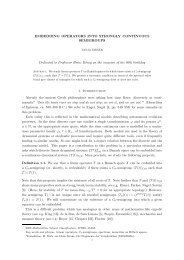Proceedings of the 13 ESSLLI Student Session - Multiple Choices ...
Proceedings of the 13 ESSLLI Student Session - Multiple Choices ...
Proceedings of the 13 ESSLLI Student Session - Multiple Choices ...
You also want an ePaper? Increase the reach of your titles
YUMPU automatically turns print PDFs into web optimized ePapers that Google loves.
<strong>Proceedings</strong> <strong>of</strong> <strong>the</strong> <strong>13</strong> th <strong>ESSLLI</strong> <strong>Student</strong> <strong>Session</strong><br />
Figure 1: A human user conversing with an artificial DP in our interaction environment<br />
(structured as in section 2). A dialogue recorder wiretaps <strong>the</strong>ir conversation.<br />
We do not (and do not need to) take into account <strong>the</strong> content <strong>of</strong> <strong>the</strong> dialogues and<br />
in fact we limit our speech analysis to simple prosodic features for <strong>the</strong> EoT prediction.<br />
Thus, for this work, we abstract away from all questions <strong>of</strong> content management and let<br />
our dialogue participants speak randomly selected pre-recorded utterances – though with<br />
proper turn-taking.<br />
The remainder <strong>of</strong> <strong>the</strong> paper is structured as follows: Section 2 describes <strong>the</strong> system<br />
architecture and Section 3 <strong>the</strong> corpora we use. Section 4 evaluates <strong>the</strong> speech state classification<br />
and Section 5 demonstrates and evaluates some simple turn-management strategies.<br />
We close with conclusions and ideas for fur<strong>the</strong>r work.<br />
2 Architecture <strong>of</strong> <strong>the</strong> Interaction Environment<br />
Our architecture defines an interaction environment in which dialogue participants (DPs)<br />
communicate with each o<strong>the</strong>r. Interaction is purely non-symbolic, using asynchronous<br />
audio streams over RTP (Schulzrinne, Casner, Frederick and Jacobson, 2003). There is no<br />
common clock, or o<strong>the</strong>r synchronisation required between DPs. The architecture provides<br />
a headset tool for human DPs, and monitoring tools to listen to ongoing dialogues and to<br />
record <strong>the</strong>m to disk.<br />
Figure 1 shows two dialogue participants – one human, one artificial – conversing in<br />
<strong>the</strong> environment described above. The artificial DP on <strong>the</strong> right <strong>of</strong> figure 1 is structured<br />
as described below.<br />
Artificial DPs are realized as modular and extensible collections <strong>of</strong> event-driven s<strong>of</strong>tware<br />
agents in <strong>the</strong> open agent architecture, OAA (Martin, Cheyer and Moran, 1999).<br />
In <strong>the</strong> OAA each s<strong>of</strong>tware agent advertises its own abilities to solve problems (such as<br />
generating utterances) and may itself request o<strong>the</strong>r agents to solve sub-problems (e. g.<br />
sending data over RTP). For audio processing inside <strong>the</strong> DP we rely on <strong>the</strong> Sphinx-4<br />
framework (Walker, Lamere, Kwok, Raj, Singh, Gouvea, Wolf and Woelfel, 2004) which<br />
we extended for our audio-processing pipeline. In <strong>the</strong> current system, we do not yet use<br />
Sphinx’ abilities as a speech recognizer and most o<strong>the</strong>r modules that would be needed for<br />
a real dialogue system are missing. These are obvious enhancements for later versions.<br />
18

















